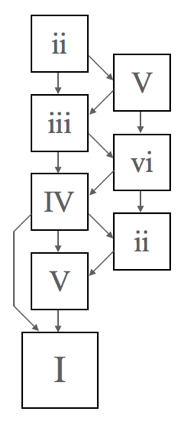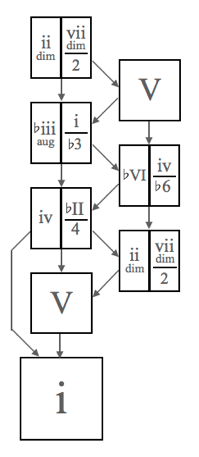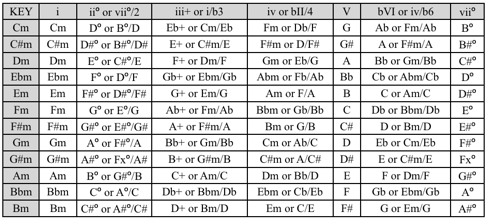
In Part Three of this series, we introduced a diagram called “The Simple Map.”
The Simple Map is designed to make it easy to explore chord progressions in major keys. It looks like this.

Notice there are two locations for the ii chord and the V chord. If you are at one of the two locations for a given chord, you can jump to the other one as though they were connected. This would allow you, for example, to go from IV to V to vi, or IV to ii to iii.
Using the Simple Map
The Simple Map can be used this way. Start with I. Jump anywhere. Follow the arrows until you arrive back at I. This gives chord progressions like:
I - IV - I
I - V - I
I - IV - V - I
I - vi - IV - V - I
I - V - vi - IV - I
I - iii - vi - ii - V - I
Or you can begin anywhere and go for a set number of chords. Let’s choose four chords.
ii - iii - IV - V
ii - V - iii - vi
V - iii - vi - IV
vi - IV - ii - V
(By the way, it isn’t a requirement to follow the arrows all the time, but if you are just beginning it can be helpful to learn these arrow progressions and how they sound.)
A Simple Map for Minor Keys
When we move to minor keys, an interesting thing happens. Let’s explain it this way.
In major keys, there is a strong tendency to allow the chord to have its root as the bass note. For example, if the chord is C major, there’s a good chance the bass note will be C. If the chord is Dm, there’s a good chance the bass note will be D. This isn’t always true, of course, but it happens a lot.
In minor, on the other hand, there are situations where we quite often use the bass note that’s the third of the chord being played. This gives us some options at some of the locations.
Here is a Simple Map for Minor Keys. (The arrows point to the entire box, not just the left or right option.)

Let’s talk about a few things. The home chord at the bottom is now minor, so we are using the lower case “i”. The V chord hasn’t changed. It appears in two locations just as before.
The other boxes have all been split in half, indicating there are two options at each location. The first option, on the left side, is what the chord will be if the bass note is the root. The second option, the one to the right, is what the chord will be if we allow the bass note to be the third of some other chord.
Let’s take the split locations one by one, starting at the top left.
If the bass note is note 2, the chord can be ii dim, or you could try viidim/2 (meaning the chord is the diminished chord built on note 7, and the bass note is the second note of the scale).
If the bass note is note b3, the chord can be biiiaug, or you could try i/b3 (meaning the chord is the i chord, and the bass note is b3, the third note of the harmonic minor scale).
If the bass note is note 4, the chord can be iv, or you could try bII/4 (meaning the chord is the major chord built on the flatted 2 note, and the bass note is the fourth note of the scale —this chord is called the Neapolitan).
In the middle box on the right side of the diagram, if the bass note is b6, the chord can be VI, or you could try iv/b6 (meaning the chord is the iv chord, and the bass note is b6, the sixth note of the harmonic minor scale).
When we expand the table to allow for the extra options, it looks like this. You can choose any row and work with that group of chords. (° means diminished, x means double-sharp, and bb stands for double-flat.)

Exploring Chord Progressions in Minor Keys
In Part Fourteen, we looked at the progression i - iv - V - i. Let’s explore some others.
iidim - V - i
A common progression in major keys is ii - V - I. In minor, the progression will be iidim - V - i. The map suggests that we can also use viidim/2. (Another option would be iidim7 to V to i.)
i - viidim/2 - i/b3
In this progression, the bass note moves from note 1 to 2 to b3. The chord changes from i to viidim to i. This also works in reverse, starting with i/b3 and ending with i.
bII/4 - V - i
This chord, bII/4, is called the Neapolitan. It’s very similar to iv, but one note has been changed in the chord (scale note 1 has been moved up a half step to the note b2). Because this is a major chord, we sometimes leave the third, which is the note the bass is playing, out of the right hand.
i - VI - iv - V - i
The VI chord in minor keys is a major chord. In the key of C minor, this progression would be Cm to Ab to Fm to G to Cm.
i - VI - bII/4 - V - i
Starting with the same progression, we can use the Neapolitan instead of the iv chord. In the key of C minor, this progression would be Cm to Ab to Db/F to G to Cm.
i - iv - i/5 - V - i
This progression uses a chord not on the Simple Map. It’s the i/5 chord, meaning the chord is the i chord but the bass is the fifth note of the scale. This chord is very useful as it sets up the V to i ending. You can also experiment with i to iidim to i/5 to V to i.
Let’s Review
Referring back to the Simple Map for major keys, introduced in Part Three, we adapted it for use with minor keys. We found that some of the locations stay the same, and others split in half to allow for more than one option when exploring that location.
We listed these options in a table, encouraging the user to explore one row at a time.
Then we suggested some specific progressions, including:
i - iv - V - i
iidim - V - i
i - viidim/2 - i/b3
bII/4 - V - i
i - VI - iv - V - i
i - VI - bII/4 - V - i
i - iv - i/5 - V - i
When you feel confident with these ideas, move ahead to Part Sixteen.
OTHER RESOURCES
PDF eBook
The materials presented in Section 1 (Parts 1-12) are available as a downloadable PDF eBook. Click for more information.
Yours To Play It
...free, interactive, chord-exploring MIDI controller app for
Windows computers.
ChordMapMidi
...interactive, chord-exploring MIDI controller app for iPhone.
ChordMaps2
...interactive, chord-exploring MIDI controller app for iPad.
CarolPlayMidi (Christmas Carols and Hymns), DrumMapMidi (basic
drum patterns), and PowerPlay5 (play power chords on iPhone) are
our other iPad and iPhone MIDI controller apps.
______________________
Music Theory for Songwriters is part of MugglinWorks.com
Built with Mobirise website template